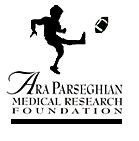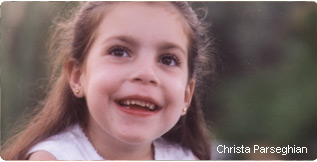Cause
In 1997 medical researchers funded by the Parseghian Foundation identified the location of a gene called NPC1 that is abnormal in patients with Niemann-Pick Type C disease. The NPC1 gene is on chromosome 18 and is normally present in two copies in each cell of the body. However, alterations or mutations in this gene cause about 95 percent of cases of NP-C disease.
In a second smaller group of patients with NP-C, alternations in NPC1 do not cause the disease. Researchers suspect a second gene, called NPC2, may be responsible.
Niemann-Pick Type C disease is known as an autosomal recessive inherited condition. This means that each parent of an affected child has one functional NPC1 gene, plus one non-functional NPC1 (or more rarely, NPC2) gene. These parents are called carriers, or heterozygotes, and exhibit no signs or symptoms of the disease.
Affected children inherit two non-functional NP-C genes from their parents.
In each pregnancy of a carrier couple, there is a one in four (25 percent) chance that they will both pass their non-functional NP-C genes to a child who would then be affected. There is a one in two (50 percent) chance that only one of them would pass a non-functional gene. The child would then be a carrier like the parents. There is a 25 percent chance that both functional genes would be passed and the child would be neither a carrier nor affected with the disease.
Signs & Symptoms
NP-C is a variable condition. This means that it can begin to affect individuals before birth or may not become evident until adulthood.
The classic form of the disease accounts for 50 to 60 percent of all cases. In this form, prenatal development and early childhood are usually normal, although jaundice may be present at or shortly after birth. Concern about behavioral problems may develop upon entry into school. The child will progressively develop loss of intellectual function, clumsiness, and difficulty with upward and downward eye movements.
In childhood, spleen or liver enlargement may be noted. Difficulties with speech (such as slurring), problems with swallowing, and in some cases, seizures may occur. Psychiatric disturbances may develop. Other symptoms
may include sudden loss of muscle strength, which may vary from head nodding to complete collapse, abnormal posturing of the limbs, and lung complications.
Death from complications of the disease usually occurs in the teenage years or early adulthood. It is important to note that the early symptoms of NP-C may vary significantly in childhood. Among the other symptoms children may experience are:
- liver failure without neurologic symptoms
- jaundice at birth
- early development of neurological problems
- low muscle tone
- delayed motor development beginning before age 2
- progressive liver failure starting in infancy
- early lung involvement without neurologic disease
- seizures
Late occurring cases typically have a less dramatic onset of symptoms. In these children and young adults, intellectual and psychiatric symptoms are the most significant.
Diagnosis & Testing
Due to the wide variability of early symptoms of NP-C, clinical diagnosis of the condition may be difficult. Physicians who suspect this diagnosis may proceed to specialized testing based on the presence of several symptoms.
Suspected patients usually have a small piece of skin removed (skin biopsy). The skin cells are grown in the laboratory and are tested for their ability to process cholesterol and for accumulation of cholesterol in certain locations in the cells. Results from both types of testing are needed to identify the classic and other forms of NP-C and to eliminate other possible causes of the symptoms.
There are two labs in the United States that conduct diagnostic testing for Niemann-Pick Type C Disease:
Contact: John O'Brien, Mayo Clinic, Rochester, MN - Obrien.john@mayo.edu
Contact: David Wenger, Thomas Jefferson University - David.Wenger@jefferson.edu
With the identification of NPC1, it is now possible to identify changes in this gene. These changes, called mutations, affect how this gene works. In groups of NP-C patients from Nova Scotia and Hispanics in southern Colorado and northern New Mexico, a common gene change has been identified. However, most patients with NP-C have unique mutations in the NPC1 gene. This makes it difficult to use DNA studies to make an initial diagnosis of the condition.
DNA Analysis
If laboratory testing reveals that the cholesterol processing and storage findings are consistent with NP-C, it is possible to analyze the patient's NPC1 gene for mutations through Mayo Clinic in Rochester, Minnesota. A blood or skin sample is obtained from the patient, and then the DNA, or genetic material, is collected from the cells in the sample. Laboratory studies of the DNA look for gene alterations that change the way the NP-C protein functions. If changes or mutations are found, the information may be used to accurately determine whether other family members also have changes in their NP-C genes. Sometimes it will not be possible to identify both genetic changes or mutations in the NPC1 gene pair in an affected individual.
Caution must be exercised when using DNA results from an affected family member for carrier testing in unaffected relatives. Because NP-C is a variable disorder, unaffected younger siblings of the patient, or in some cases even
unaffected older siblings, could have two copies of the genetic
changes that cause the disease, but not yet have symptoms. Prior to testing, it is vital to discuss all of the implications of genetic testing for NP-C with a medical geneticist or genetic counselor.
If an unaffected relative of an NP-C patient, such as a sibling or cousin, were to be identified as a carrier, this would increase the risk for NP-C in a future pregnancy for that person. It is somewhat possible to determine whether this individual's partner is also a carrier to determine risk for the disease in a future pregnancy.
Contact Brittany Thomas at Mayo Clinic in Rochester, MN for more information on Niemann-Pick Type C DNA Analysis and Carrier Testing: thomas.brittany@mayo.edu
Treatment
While there not yet a specific treatment for NP-C, supportive therapies are available. These include medications to control seizures, abnormal posturing of limbs and tremors. Physical, speech and occupational therapy are also used to help with daily functioning.
Identification of the NPC1 gene is helping researchers in the development of potential therapies.
Already attempts have been made to correct the cell changes seen in NP-C by using liver or bone marrow transplantation and by cholesterol-lowering medications. Thus far, these have had no effect on delaying the neurologic deterioration or progression of the disease.
Back to top





